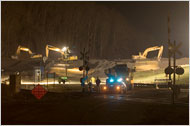TVA ash spill in NYT
December 26th, 2008
Clean coal? Ask anyone near TVA’s Kingston Plant… THERE IS NO SUCH THING AS CLEAN COAL!
Yesterday’s New York Times had the TVA ash spill front and center:
Clean up is going to be a long, slow, costly process, and can it even be cleaned up?
And here’s a review of the “Issues of Hazards” raised in the article:
Similarly, a 2006 study by the federally chartered National Research Council found that these coal-burning byproducts “often contain a mixture of metals and other constituents in sufficient quantities that they may pose public health and environmental concerns if improperly managed.” The study said “risks to human health and ecosystems” might occur when these contaminants entered drinking water supplies or surface water bodies.
In 2000, the Environmental Protection Agency proposed stricter federal controls of coal ash, but backed away in the face of fierce opposition from utilities, the coal industry, and Clinton administration officials. At the time, the Edison Electric Institute, an association of power utilities, estimated that the industry would have to spend up to $5 billion in additional cleanup costs if the substance were declared hazardous. Since then, environmentalists have urged tighter federal standards, and the E.P.A. is reconsidering its decision not to classify the waste as hazardous.
And regarding coal ash dump pollution:
Another 2007 E.P.A. report said that over about a decade, 67 towns in 26 states had their groundwater contaminated by heavy metals from such dumps.
